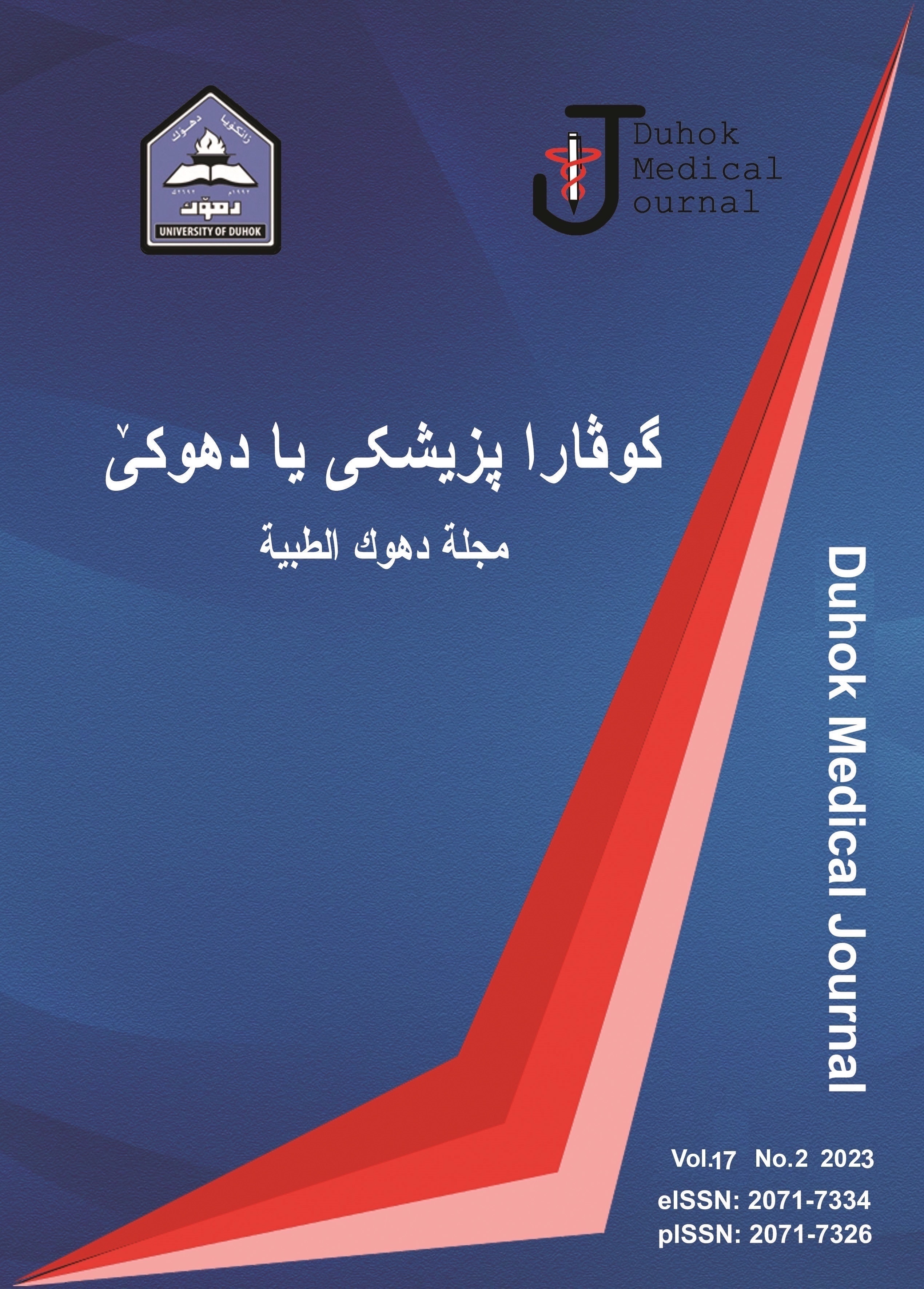BETA GLOBIN GENE CLUSTER HAPLOTYPES IN IRAQI KURDS
Abstract
https://doi.org/10.31386/dmj.2023.17.2.1
Background: The study of β-globin gene cluster haplotypes provides insight into the origin, migration and genetic variation of human populations, it also constitutes an essential prelude to studying such haplotypes among those with hemoglobin disorders in a given population.
Materials and Methods: A total of fifty unrelated healthy non-thalassemic Iraqi Kurds were recruited. Their DNAs were extracted, and their β-globin gene cluster haplotypes were determined using restriction fragment length polymorphisms technique at seven restriction sites along the β-globin gene cluster, namely: HindII 5’ε, HindIII Gγ, HindIII Aγ, Hind II 5’ψβ, Hind II 3’ψβ, AvaII β, and BamHI 3’β.
Results: The enrolled individuals had a median age of 15 years and included 26 males and 24 females. Haplotype analysis identified 17 different haplotypes, including seven atypical ones. The most frequent haplotypes among the 100 chromosomes analyzed were haplotypes I, III, V and IX at rates of 32%, 14%, 12%, and 9% respectively. These were arranged in 28 different genotypes, the most frequent of which were I/III, I/IX, I/I and V/V at rates of 14%. 8%, 8%, and 8% respectively. There were significant differences between Yazidi and Muslim Kurds haplotype distributions. The most informative of the seven markers employed in the current study with highest polymorphism information content was HindII 5’ε and HindIII Gγ, while the least was Hind IIIAγ.
Conclusion: β-globin cluster haplotype distribution at the βA chromosomes among Iraqi Kurds shares a lot of similarities with that in neighboring countries. The high rate of heterogeneity noted may be due to the ancient origin of the population, while the differences observed between Muslims and Yazidis maybe the consequence of genetic isolation of the latter subgroup at least for the last millennium. This study paves the way to further studies on haplotypes associated with β-globin gene disorders to have a better insight into their origin and spread in Iraqi Kurdistan.
Downloads
References
2. Orkin SH, Kazzazian Jr HH, Antonarakis SE, Goff C, Boehm CD, Sexton JP, Waber PG, Giardina PJ. Linkage of β-thalassemia mutations and β-globin gene polymorphisms with DNA polymorphisms in human β-globin gene cluster. Nature 1982; 296; 627-632.
3. Wainscoat JS, Hill AVS, Boyce AL, Flint J, Hernandez M, Thein SL, et al. Evolutionary relationship of human populations from the analysis of nuclear DNA polymorphisms. Nature 1986; 319: 491-493.
4. Long JC, Chakravarti A, Boehm CD, Antonarakis S, Kazazian HH. Phylogeny of human beta-globin haplotypes and its implications for recent human evolution. Am J Phys anthropol 1990; 81: 113-130.
5. Callegari-Jacques SM, Crossetti SG, Kohlrausch FB, Salzano FM, Tsuneto LT, Petzl-Erler ML, Hill K, Hurtado AM, Hutz MH. The beta-globin gene cluster distribution revisited-patterns in native American populations. Am J Phys Anthropol 2007; 134:190-197.
6. Aggarwal A, Khurana P, Mitra S, Raicha B, KN Saraswathy, Italia YM, Kshatriya GK. Distribution of beta-globin haplotypes among the tribes of Western Gujarat, India. Gene 521, 287-292.
7. Old J, Traeger-Synodinos J, Galanello R, Retrou M, Angastiniotis M. Prevention of thalassemia and other haemoglobinopathies. Vol 2. Thalassemia International Federation, Nicosia, Cyprus, 2005.
8. Lee YJ, Park SS, Kim JY, Cho HL. RFLP haplotypes of β-globin gene complex of β-thalassemic chromosomes in Koreans. J Korean Med Sci 2002; 17: 475-478.
9. Botstein D, White RL, Skolnick M, Davis RW. Constructing a genetic linkage map in man using restriction fragment length polymorphisms. Am J Hum Genet 1980; 32(3): 314-331.
10. Rahimi Z, Merat A, Akhzari M, Haghshenass M, Nagel RL, Gerard N, Krishnamoorthy R. β-globin gene cluster haplotypes in Iranian patients with β-thalassemia. IJHOBMT 2005; 2(6): 30-34.
11. Rahimi Z, Muniz A, Akramipour R, Tofighzadeh F, Mozafari H, Vaisi-Raygani A, Parsian A. Haplotype analysis of beta thalassemia patients in Western Iran. Blood Cell Mol Dis. 2009; 42: 140-143.
12. Bahadir A, Ӧztürk O, Atalay A, Atalay EO. Beta globin gene cluster haplotypes of the beta thalassemia mutations observed in the Denzili province of Turkey. Turk J Hematol 2009; 26: 129-37.
13. Kazazian Jr HH, Orkin SH, Antonarakis SE, Sexton JP, Boehm CD, Goff SC, Waber PG. Molecular characterization of seven β-thalassemia mutations in Asian Indians. EMBO J 1984; 3(3): 593-596.
14. Pirastu M, Galanello R, Doherty MA, Tuveri T, Cao A, Kan YW. The same β-globin gene mutation is present on nine different β-thalassemia chromosomes in a Sardinian population. Proc Natl Acad Sci USA 1987; 84: 2882-2885.
15. Derakhshan SM, Khorram A, Pour Feizi AH, Khaniani MS. Spectrum of β-globin gene mutations and β-thalassemia haplotype analysis among the Iranian Azeri Turkish population. Epidemiology; Open Access 2015; 5:4.
16. Hamamy H. Consanguineous marriages. Preconception consultation in primary health care settings. J Community Genet 2012; 3; 185-192.
17. Flint J, Harding RM, Clegg JB, Boyce AJ. Why are some genetic diseases common? Distinguishing selection from other processes by molecular analysis of globin gene variants. Hum Genet 1993; 91: 91-117.
18. Zahed L, Demont J, Rouhass R, Trabuchet G. Origin and history of the IVS-I-110 and codon 39 [beta]-thalassemia mutations in the Lebanese population. Hum Biol 2002; 74(6): 837-847.
19. Star B, Spencer HG. Effects of genetic drift and gene flow on the selective maintenance of genetic variation. Genetics 2013; 194(1): 235-244.
20. Chesnokov Yu V, Artemyeva AM. Evaluation of the measure of polymorphism information of genetic diversity. Agricultural Biol 2015; 50(5): 571-578.
21. Serrote CML, Reiniger LRS, Silva KB, Rabaiolloi AMDS, Stefanel CM. Determining the polymorphism information content of a molecular marker. Gene 2020; 726:144175.






